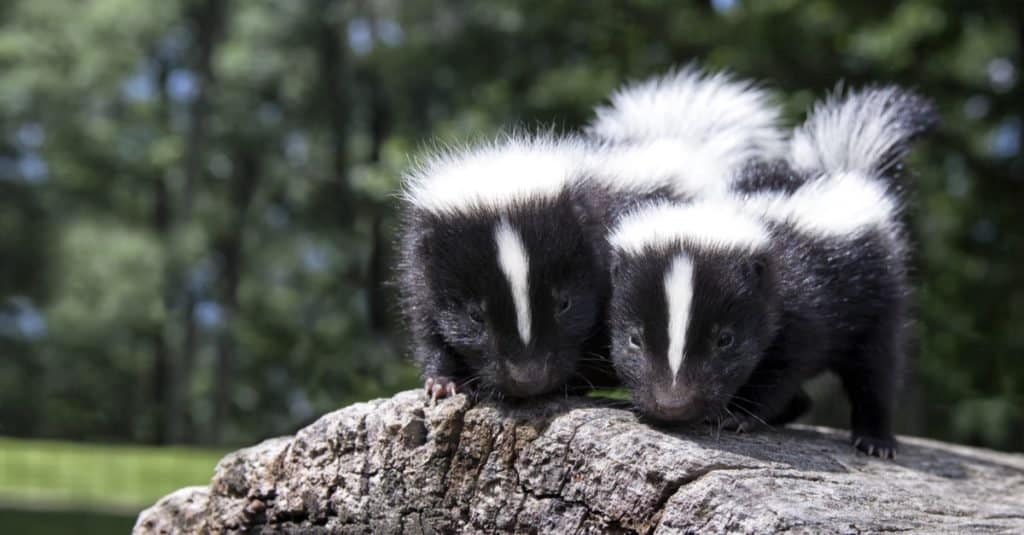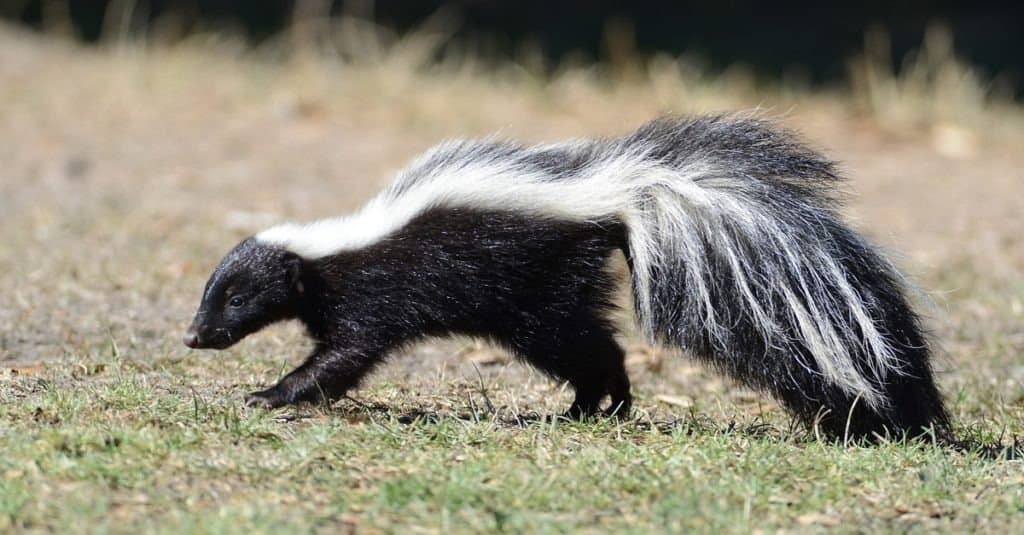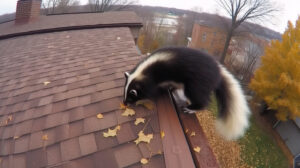They’re immune to snake venom, and they can deliver a powerful blast with an odor that travels well over a mile. But they’re pretty chill creatures that serve as beneficial rodent control. However, if you have an attractive area near your yard, skunks may just decide to take up residence. Discover 11 of the most effective ways to get rid of skunks in your yard!
Skunk Overview
It’s rather easy to identify a skunk as they have distinctive white stripes on their backs that extend to their tails. If you know the smell of a skunk’s spray, you know how strong and offensive it is. It also has a way of traveling! But this only occurs when a skunk is afraid. It’s how it defends itself. However, they’re not willy-nilly about spraying and reserve this defense mechanism for extreme situations. Skunks serve a beneficial purpose as they snack on both insects and rodents. They’re generally relaxed and avoid contact with humans. But sometimes, they get a bit too close, settling into available spaces around your property.
Some of the repellents available in the market do work, but there are some more humane ways to keep skunks out of your yard. First, you must check for their distinct smell. You do not have to try too hard; it seems as though the air is filled with their distinctive odor when they’re present. Once you know that you’re dealing with skunks, you can move forward with a few humane deterrents and what the Human Society of the United States calls “mild harassment.” You can certainly coexist with skunks — they don’t pose a danger to you. But when they want to turn your home into a denning site, you can take a few actions to let them know it’s time to move along.

Skunks are beneficial to the ecosystem but can get a bit too close when looking for a denning site.
©Jeremy Richards/Shutterstock.com
11 Most Effective Ways to Get Rid of Skunks in Your Yard
1. Don’t Overwater Your Yard
You may inadvertently be making your yard attractive to skunks. Refrain from overwatering as this provides them with the ideal opportunity to snack on grubs. When the soil is wet, grubs get pushed up to the surface. That’s when skunks are grateful for the available spread — it’s as if you’ve just set up the table for them and called them over for supper.
2. Seal It All Up
In order for them not to be your neighbors (or squatters in your basement), get to sealing! As skunks look for shelter under sheds and under decks, you have to be mindful of sealing off any possibility of entry. The last thing you want is for them to have babies — at that point, you’ll have more to contend with. Sealing is an exclusion technique that makes it known that your property is not a denning site. However, before you start sealing everything up, make sure you’re not accidentally trapping a skunk family that thinks it’s found a safe shelter.
3. Hide the Food
Food sources are a big deal for skunks, like any animal trying to survive. They are attracted to different food sources (even rotting ones), so you need to make sure trash bins are heavy enough. Or, you can secure them well so that skunks do not turn them over, creating a mess while they look for scraps. Try not to leave any pet food out overnight either, and avoid making birdseed available. Although birds may be welcome in your yard, unfortunately, birdseed also attracts skunks.
4. Try a One-Way Door
Mesh fencing is advisable or one-way doors for skunks to be able to exit their den sites. Pay close attention to the crawl space as they are daring, especially when they are about to have babies! Understandably, they’re looking for a safe place for their little ones. But if there are any gaps under your porch, that would be a potential home for them. If you suspect a skunk has left babies inside a den site, reach out to your local wildlife rescue or animal control to assist with their removal.

Skunks seek out denning sites to have their babies.
©critterbiz/Shutterstock.com
5. Let There Be Light
Motion-activated lighting can be a huge help to deter skunks at night. If you’d like to be a bit more sophisticated, you can always set up a motion-activated sprinkler system to go off when they try to visit you in the middle of the night. Additionally, keep the bushes trimmed enough to reduce their hiding spots. Skunks look for dark, quiet spaces where they can den, and by creating a well-lit and uncomfortably wet environment, they are likely to keep on moving to find a more suitable environment for their needs.
6. Try a Live Trap
You can also use live traps for relocation! As bait, you can use peanut butter or cat food. Just make sure you check it daily, and when one is caught, cover it with a blanket to calm it down. Of course, it’ll be terrified, and its defense mechanism is super stinky. Once it’s secure, you can release it about 10 or 15 miles away in the wilderness. If this is not something you feel comfortable doing, reach out to your local animal control services to take care of it.
7. Try Mild Repellants
You must be extremely cautious with skunks as they can spray, but only when they feel threatened. Otherwise, they’re mild-mannered. It is highly recommended to keep your distance from skunks. It only takes them one time to get startled, and then they take care of business in a not-so-nice way. Don’t try to handle a skunk or hurt it. If you have a cat, try using used litter. Spread it around the area your skunk has found attractive so it can change its mind. You can also try castor oil too!
8. Get Ultrasonic
An ultrasonic device could also be the answer, as it uses sound waves to detect moving critters. These produce a sound frequency that you can’t hear. Do not forget, however, that skunks are highly beneficial to farmers and landowners as they eat the majority of garden pests. So, while they shouldn’t be getting so comfortable that they try to move in, they do serve their purpose in the wild.

Different mild repellants can get skunks to keep it moving and avoid your property altogether.
©Matt Knoth/Shutterstock.com
9. Create Your Own DIY Solution
You can always make a natural DIY solution that’s easy to put together and saves you from having to purchase any specialized repellant. Mix castor oil, dishwashing detergent, and water in a spray bottle. This is one humane way of saying “stop” without having to confront skunks and risk getting sprayed. Get out to your yard, around your porch, and any crawl space doors to spray your mixture and send a message to any skunks looking to settle in.
10. Get Out the Ammonia
You can place rags or cotton balls soaked in ammonia around the property. They do not like the smell as it irritates their eyes, which forces them to retreat. You or your pets probably won’t like the smell, either. But it does work as a short-term solution. It’s not a one-and-done deterrent, but it’s relatively affordable.
11. Get Loud
If skunks are far enough, you can make a lot of noise so that they (hopefully) run away. But if they’re bold and decide to walk toward you, get out of their way. Ultimately, skunks are seeking a safe, quiet, dark place to get cozy in. If your yard is well-lit and they hear the sound of human voices, they’re unlikely to approach. Even music or a podcast can be noisy enough for them to keep it moving.
The photo featured at the top of this post is © Yasmins world/Shutterstock.com
Thank you for reading! Have some feedback for us? Contact the AZ Animals editorial team.





